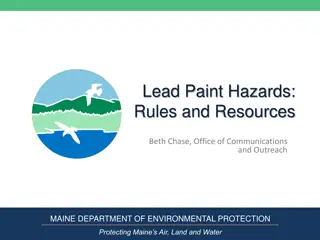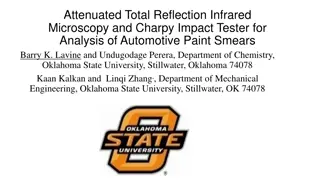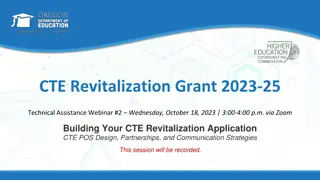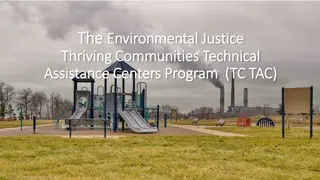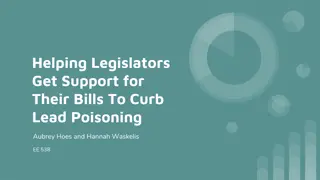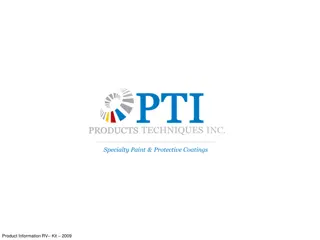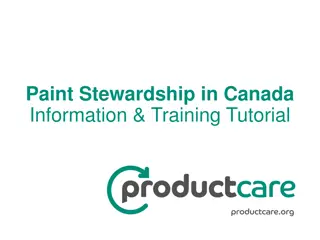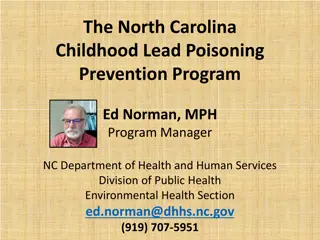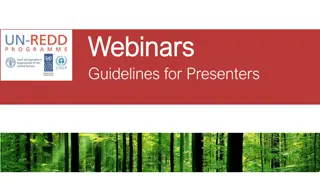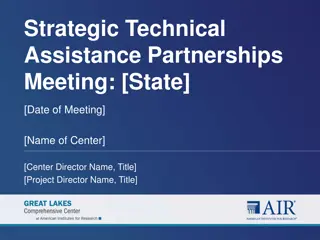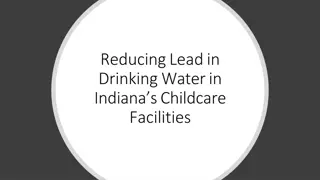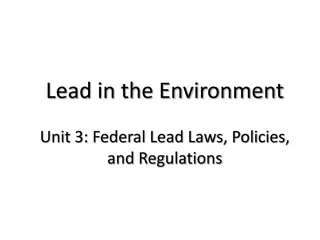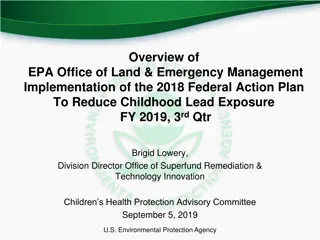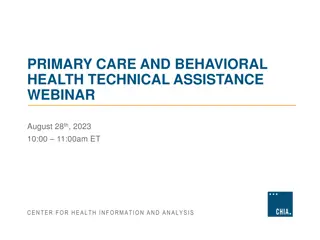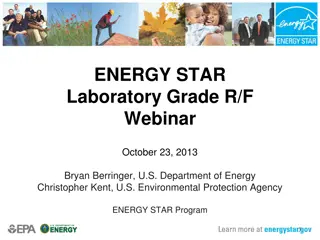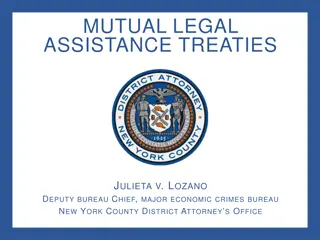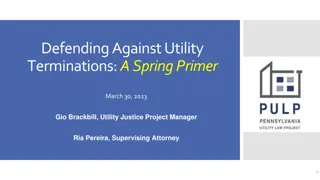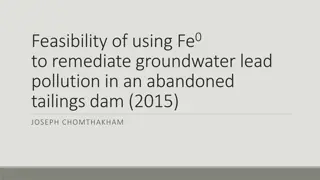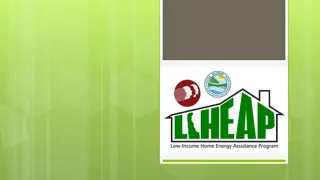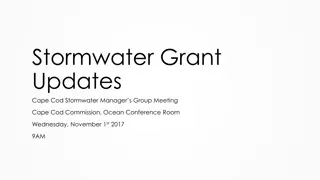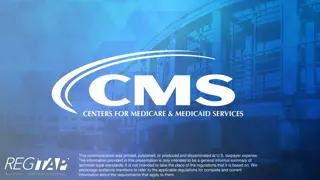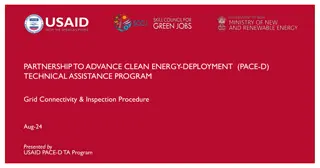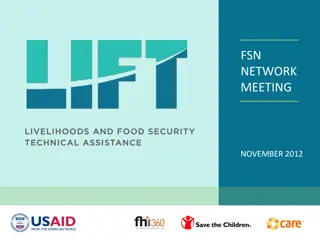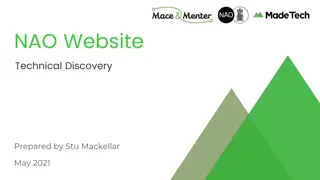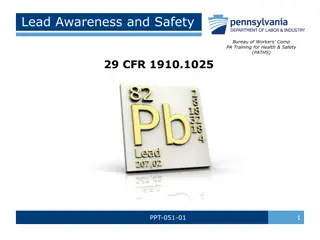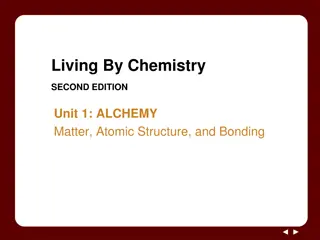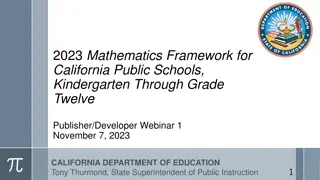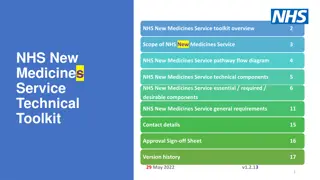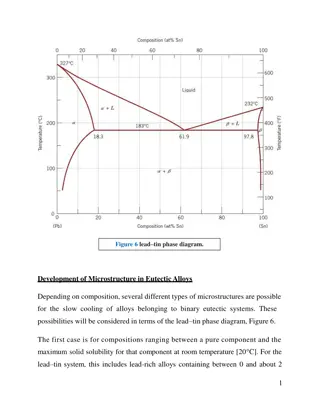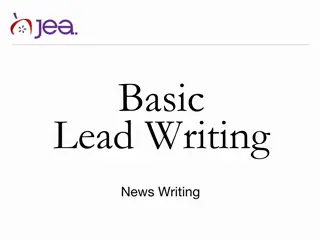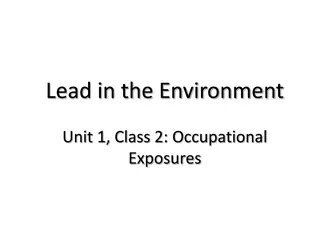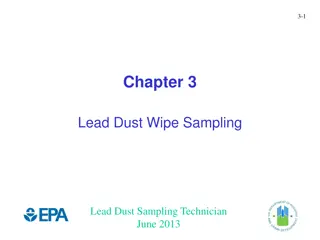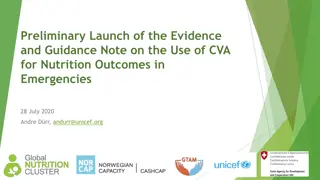Lead Paint Technical Assistance Webinar Overview
Indiana State Department of Health's lead paint technical assistance webinar covered various topics such as new lead-focused programs, state licensing requirements, EPA certifications, federal and state regulations, risk assessments, and policies. It highlighted lead hazard control programs, licensing requirements for different roles, and the RRP program for contractors. The session emphasized the importance of following lead-safe work practices and proper supervision in lead-based paint activities.
Download Presentation

Please find below an Image/Link to download the presentation.
The content on the website is provided AS IS for your information and personal use only. It may not be sold, licensed, or shared on other websites without obtaining consent from the author. Download presentation by click this link. If you encounter any issues during the download, it is possible that the publisher has removed the file from their server.
E N D
Presentation Transcript
IHCDA LEAD BASED PAINT TECHNICAL ASSISTANCE WEBINAR FEBRUARY 28, 2018 MARCH 2, 2018 PRESENTED BY: DAVE PUGH
PRESENTATION TODAY New Lead focused programs State Licensing requirements EPA Certifications Federal and State Regulations Risk Assessments Policy
LEAD HAZARD CONTROL PROGRAMS 1. Lead Hazard Reduction Demonstration Grant 2. Balance of State 3. CHIP
LICENSING REQUIREMENTS The Indiana State Department of Health requires the following to be licensed: Risk Assessors Lead Inspectors Project Supervisor license (Abatement) Contractors (Abatement) Project Designer (Abatement) Worker License (Abatement) Clearance Examiner Indiana State Department of Health (ISDH) Lead Professional Licensing Overview https://www.in.gov/isdh/19153.htm Indiana Professional Licensing Agency https://mylicense.in.gov/everification/Search.aspx
RENOVATION, REPAIR, & PAINTING PROGRAM (RRP)- CONTRACTORS In general, anyone who is paid to perform work that disturbs paint in housing and child-occupied facilities built before 1978 must be EPA certified. This includes all firms, even sole proprietorships. Examples of the types of firms covered: Residential rental property owners/managers General contractors Special trade contractors, including Painters Plumbers Carpenters Electricians https://www.epa.gov/lead/renovation-repair-and-painting-program
LSHR AND INTERIM CONTROLS A person performing interim controls must be supervised by an individual licensed as a lead-based paint abatement supervisor or have successfully completed one of the following lead-safe work practices courses: A lead-based paint abatement supervisor course accredited in accordance with 40 CFR 745.225 A lead-based paint abatement worker course accredited in accordance with 40 CFR 745.225; or A renovator course accredited in accordance with 40 CFR 745.225.
RRP- RENOVATORS Federal law requires that a certified renovator be assigned to each job, and that all involved individuals are trained in the use of lead-safe work practices. https://cfpub.epa.gov/flpp/pub/index.cfm?do=main.trainingSearch
EPA RULE PART 745- LEAD BASED PAINT POISONING PREVENTION IN CERTAIN RESIDENTIAL STRUCTURES This subpart contains regulations developed under sections 402 and 406 of the Toxic Substances Control Act (15 U.S.C. 2682 and 2686) and applies to all renovations performed for compensation in target housing and child-occupied facilities. The purpose of this subpart is to ensure the following: (a) Owners and occupants of target housing and child-occupied facilities receive information on lead- based paint hazards before these renovations begin; and (b) Individuals performing renovations regulated in accordance with 745.82 are properly trained; renovators and firms performing these renovations are certified; and the work practices in 745.85 are followed during these renovations. https://www.ecfr.gov/cgi- bin/retrieveECFR?gp=&SID=b1c2b29dd0c663462ae20cc2c875412a&mc=true&n=pt40.34.745&r=PART &ty=HTML
HUDS LEAD SAFE HOUSING RULE (LSHR) 24 CFR Part 35 Covers all Federally-assisted or owned target housing Effective September 15, 2000 Requirements depend on type and amount of federal housing assistance https://www.hud.gov/program_offices/healthy_homes/enforcement/lshr HUD Guidelines for the Evaluation & Control of Lead-Based Paint Hazards in Housing https://www.hud.gov/program_offices/healthy_homes/lbp/hudguidelines Interpretive Guidance on HUD s Lead Safe Housing Rule https://www.hud.gov/sites/documents/DOC_25476.PDF
EXEMPTIONS TO THE LSHR Any rehabilitation that does not disturb a painted surface Residential property for which construction was completed on or after Jan 1, 1978 Zero-bedroom units, including single room occupancy (SRO) units Housing exclusively for elderly or disabled (see HUD definition) in 35.110 Property evaluated as free of lead-based paint (LBP) or where LBP was removed Property or part of property that is not used for human residential habitation * Historic Preservation exemption- listed as eligible, or contributes to a historic district
RISK ASSESSMENTS In residential dwellings, dust samples (either composite or single-surface samples) from a window (sill) and floor shall be collected in all living areas where one (1) or more children, six (6) years of age or younger, are likely to come into contact with dust. 410 IAC 32-4-4 Chapter 5 of HUD s Guidelines for the Evaluation & Control of Lead-based Paint Hazard in Housing recommend that risk assessors select a minimum of four rooms for dust sampling (except, of course, when the dwelling unit has less than four rooms). The rooms generally recommended for sampling, in approximate order of importance, are: 1. the principal play area of young children, 2. the kitchen, 3. the bedroom of the youngest child, 4. the bedroom of the next oldest child, 5. the bathroom used by the youngest child, and 6. the living room. * If no children under age six are in residence, one can presume that the smaller bedrooms are those that would be used by young children and that the living room or family room would be the principal play area Bare soil areas to be sampled for lead contamination are 1. Each play area with bare soil, including sandboxes 2. Non-play areas in drip line/foundation areas 3. Non-play areas in the rest of the yard, including, but not limited to vegetable gardens, pet sleeping areas, and bare soil 4. Vegetable gardens
RISK ASSESSMENT 410 IAC 32-4-4 The licensed risk assessor shall prepare a risk assessment report that shall include the following information: (A) The date of the assessment including visual inspections. (B) The address of each building. (C) The date of construction. (D) The apartment number, if applicable. (E) The name, address, and telephone number of each owner or owners of each residential dwelling or child-occupied facility. (F) The name, signature, and license number of the licensed risk assessor conducting the assessment. (G) The name, address, and telephone number of the firm employing each licensed risk assessor. (H) The name, address, and telephone number of each recognized laboratory conducting analysis of the collected samples. (I) Each testing method, device, or sampling procedure employed for paint analysis, including quality control data and, if used, the serial number of any x-ray fluorescence device. (J) Specific locations of each painted component tested for the presence of lead-based paint. (K) All results of laboratory analysis on collected paint, soil, and dust samples.
RISK ASSESSMENT 410 IAC 32-4-4 (L) Any background information collected. (M) To the extent that they are used as part of the lead-based paint hazard determination, the results of any previous inspections or analyses for the presence of lead-based paint or other assessments of lead-based paint-related hazards. (N) A description of the location, type, and severity of lead-based paint hazards and other potential lead hazards. (O) A description of interim controls and abatement options for each identified lead-based paint hazard and a suggested prioritization for addressing each hazard. If the use of an encapsulant or enclosure is recommended, the report shall recommend a maintenance and monitoring schedule for the encapsulant or enclosure. (P) Results of visual inspections. The licensed risk assessor shall submit documentation of the inspection in the format prescribed by the department within five (5) business days after completing the risk assessment report. http://www.in.gov/legislative/iac/T04100/A00320.PDF I-Lead- managed by the ISDH- https://gatewayp.isdh.in.gov/Gateway/SignIn.aspx
EXAMPLE OF A BASIC INTERIOR DUST SAMPLING PLAN Dust samples should be collected from each of the following locations: One from the floor of the youngest child s principal play area, usually the living room One from the interior window sill of the most frequently opened window in the living room. One from the floor of the kitchen. One from an interior window sill in the kitchen. One from the floor of the bedroom of the youngest child (older than 6 months). One from the interior window sill of the bedroom of the youngest child (older than 6months) One from the floor of the bedroom of the next oldest child, if any. One from the interior window sill of the bedroom of the next oldest child. One from the floor and window sill of every other room selected by the risk assessor. One from the floor inside the most frequently used door that provides direct access to the outdoors. * One field blank per property If no playroom can be identified, the living room should be sampled. If the youngest child s bedroom cannot be identified, the smallest bedroom should be sampled.
DE MINIMIS LEVELS Work which disturbs less than 20 square feet on exterior surfaces 2 square feet in any one interior room or space 10 percent of total surface area of interior or exterior component type with a small area (sills, baseboards, etc.) Exemption to Safe Work Practices and Clearance only
ABATEMENT Intent is to permanently eliminate LBP or LBP hazard(s) Licensed lead abatement contractor Methods include- Encapsulation, enclosure, component replacement or removal of paint Paving or removal for soil Clearance by inspector or risk assessor https://portalapps.hud.gov/CORVID/HUDLBPAdvisor/info/documents/HUD- EPAabateguidance.pdf
SET-UP AND INSPECTIONS Set-up 1. Lead Inspector/Risk Assessor name and license 2. Certified RRP Firm certificate 3. Lead Abatement Supervisor/Contractor/worker license (if applicable) 4. Certified renovator certificates Owner-occupied rehab and Rental Rehab 1. Detailed scope of work 2. Signed Inspection Certification form (inspector, contractor, owner) 3. Lead form New Construction 1. Signed Inspection Certification form 2. Development Design commitments 3. Planned work
WEB LINKS EPA Lead Rules- https://www.ecfr.gov/cgi- bin/retrieveECFR?gp=&SID=b1c2b29dd0c663462ae20cc2c875412a&mc=true&n=pt40.34.745&r=PART&ty=HTML RRP Rules- https://www.epa.gov/lead/renovation-repair-and-painting-program RRP Certified Firm Verification- https://cfpub.epa.gov/flpp/pub/index.cfm?do=main.firmSearch RRP Renovator Training- https://cfpub.epa.gov/flpp/pub/index.cfm?do=main.trainingSearch HUD LSHR- https://www.hud.gov/program_offices/healthy_homes/enforcement/lshr Interpretive Guidance on HUD s Lead Safe Housing Rule- https://www.hud.gov/sites/documents/DOC_25476.PDF HUD Guidelines for the Evaluation & Control of Lead-Based Paint Hazards in Housing- https://www.hud.gov/program_offices/healthy_homes/lbp/hudguidelines HUD Abatement Guidance- https://portalapps.hud.gov/CORVID/HUDLBPAdvisor/info/documents/HUD- EPAabateguidance.pdf ISDH Lead Rules- http://www.in.gov/legislative/iac/T04100/A00320.PDF Indiana State Department of Health (ISDH) Lead Professional Licensing Overview- https://www.in.gov/isdh/19153.htm I-Lead- managed by the ISDH- https://gatewayp.isdh.in.gov/Gateway/SignIn.aspx Indiana Professional Licensing Agency (IPLA)- https://mylicense.in.gov/everification/Search.aspx IHCDA Program Manual- http://www.in.gov/myihcda/files/CDBG,%20HOME,%20HTF%20Program%20%20Manual%204thEdition.pdf
For Further Information Sign up for our email list for newsletters and notices If you want an IHCDA contact name for a specific program, let us know Contact Info: Dave Pugh Lead Grant Manager 317-234-6289 dpugh@ihcda.in.gov IHCDA Contact Info: 317-232-7777 askihcda@ihcda.in.gov
Thank you QUESTIONS?


